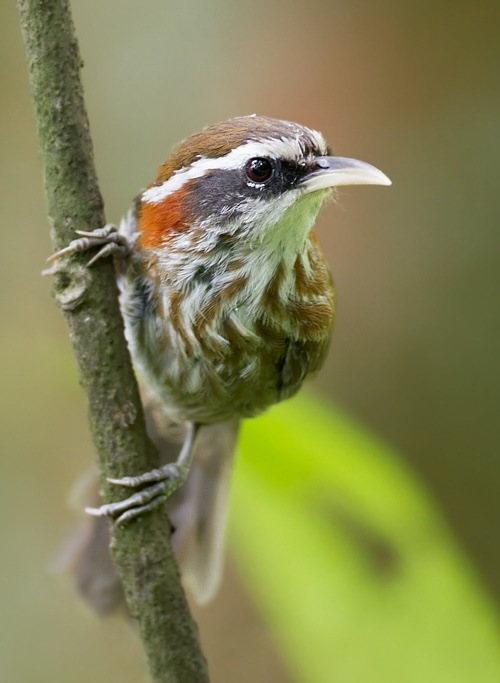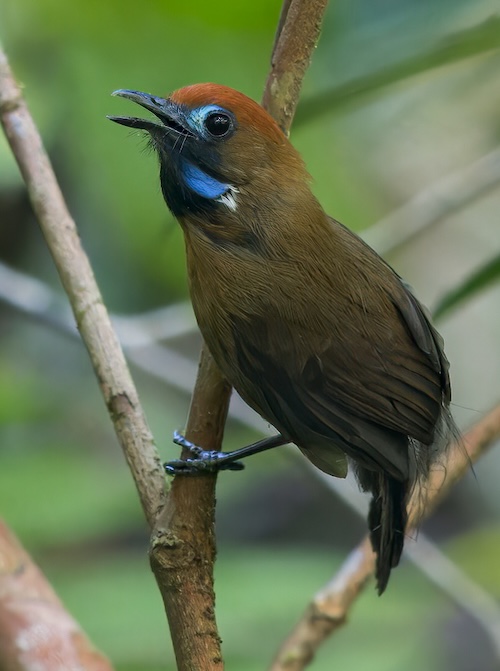Timaliidae – Tree & Scimitar Babblers
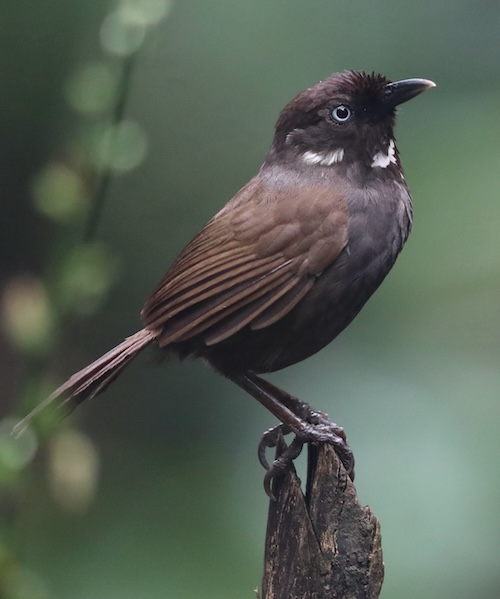
The Timaliidae is a large family with a lot of recent work on DNA sequencing changing orders and leading to several splits, lumps and reassignments. Moreover, it has now spawned several new families Leiothrichidae (Laughingthrushes) and Pellorneidae (Fulvettas & Ground Babblers)], which are treated separately leaving only the following genera in this family: Timalia, Dumetia, Mixornis, Macronus, Cyanoderma, Spelaeornis, Melanocichla, Pomatorhinus, Erythrogenys and Stachyris.
They are a family of mostly Old-World passerines. They are rather diverse in size and coloration, but are characterised by soft fluffy plumage. These are birds of tropical areas, with the greatest variety in Southeast Asia and the Indian subcontinent. The Timaliidae & Pellorneidae are not related to the other group also called babblers – the Australasian babblers of the family Pomatostomidae (also known as pseudo-babblers).
Morphological diversity is rather high; most species resemble ‘warblers’, jays or thrushes. This group is among those Old-World bird families with the highest number of species still being discovered.
|
|
|
|
Streak-breasted Scimitar Babbler Pomatorhinus ruficollis |
Fluffy-backed Tit-Babbler Macronus ptilosus |
|
All photos on this page courtesy of ©Dubi Shapiro (Unless otherwise attributed) |
|
They are small to medium birds with strong legs, and many are quite terrestrial. They typically have generalised bills, similar to those of a thrush or warbler, except for the scimitar babblers which, as their name implies, have strongly decurved bills. Most have predominantly brown plumage, with minimal difference between the sexes, but others are more brightly coloured.
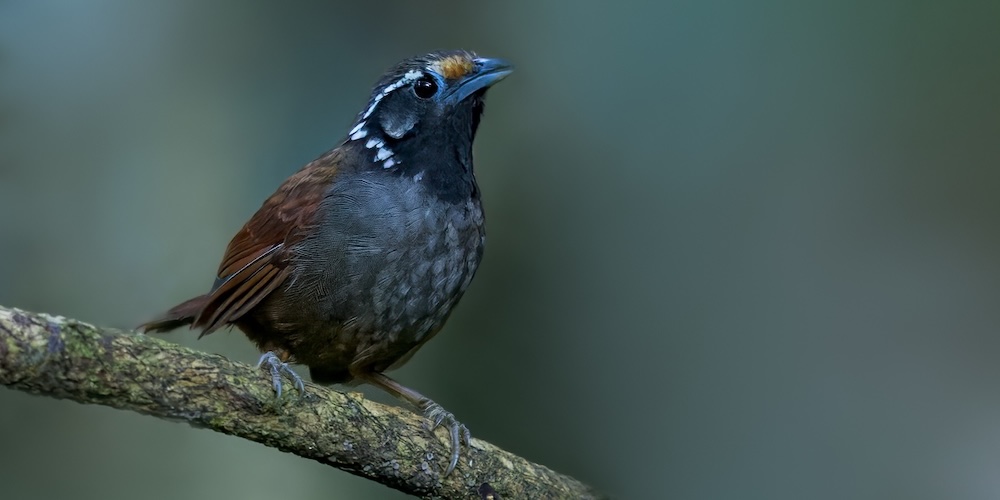
White-necked Babbler Stachyris leucotis
This group is not strongly migratory, and most species have short rounded wings, and a weak flight. They live in lightly wooded or scrubland environments, ranging from swamp to near-desert. They are primarily insectivorous, although many will also take berries, and the larger species will even eat small lizards and other small vertebrates.
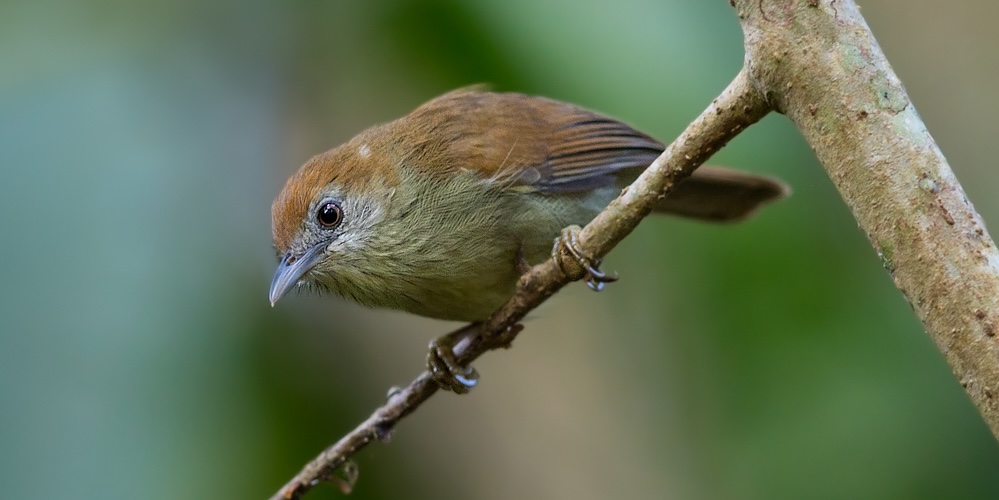
Grey-faced Tit-Babbler Mixornis kelleyi
Typical babblers live in communities of around a dozen birds, jointly defending a territory. Many even breed communally, with a dominant pair building a nest, and the remainder helping to defend and rear their young. Young males remain with the group, while females move away to find a new group, and thus avoid inbreeding. They make nests from twigs, and hide them in dense vegetation.
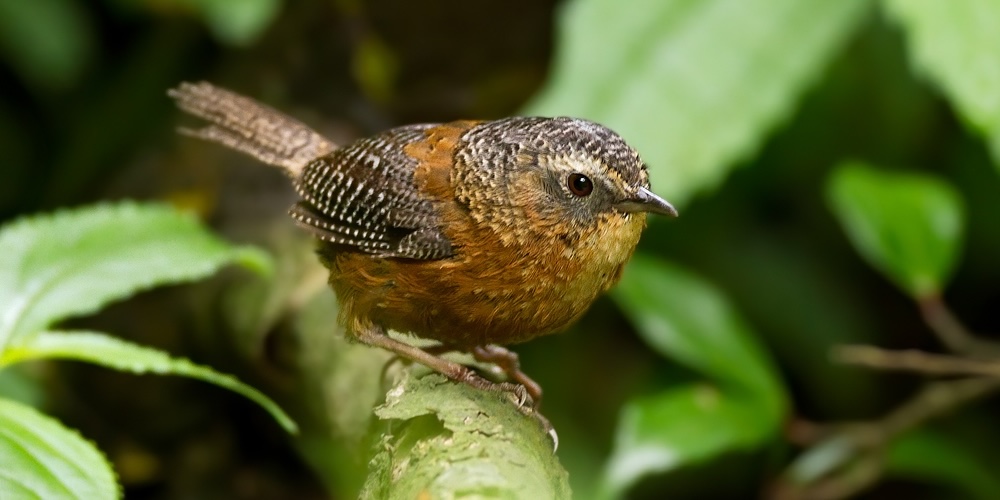
Bar-winged Wren-Babbler Spelaeornis troglodytoides
The systematics of Old-World babblers have long been contested. During much of the 20th century, the family was used as a “wastebin taxon” for numerous hard-to-place Old-World passerines (such as Picathartidae and Pnoepygidae, as well as the New World species the Wrentit). The German ornithologist Ernst Hartert summarised this attitude, saying that, in the passerines: “Was man nicht unterbringen kann, sieht man als Timalien an.” – What one can’t place systematically is considered an Old-World babbler.
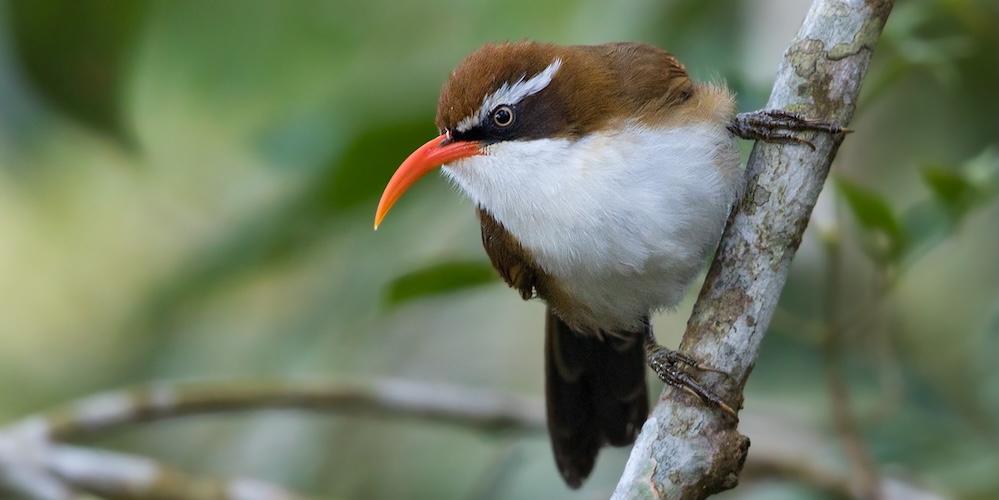
Red-billed Scimitar Babbler Pomatorhinus ochraceiceps
Timaliid vocalizations are diverse and frequently heard, and some species inflate blue-pigmented throat sacs when they sing. Many species are quite social, but quite a few of the others appear to be monogamous, defending simple all-purpose territories.
-
Number of bird species: 58
(As at October 2025)
According to the recently (2025) amalgamated AviList, there are fifty-eight species, in ten genera in the Timaliidae family including Tree Babblers, Scimitar Babblers & Allies. They are:
Chestnut-capped Babbler Timalia pileata
Tawny-bellied Babbler Dumetia hyperythra
Dark-fronted Babbler Dumetia atriceps
Grey-faced Tit-Babbler Mixornis kelleyi
Grey-cheeked Tit-Babbler Mixornis flavicollis
Kangean Tit-Babbler Mixornis prillwitzi
Pin-striped Tit-Babbler Mixornis gularis
Bold-striped Tit-Babbler Mixornis bornensis
Fluffy-backed Tit-Babbler Macronus ptilosus
Brown Tit-Babbler Macronus striaticeps
Chestnut-winged Babbler Cyanoderma erythropterum
Bicolored Babbler Cyanoderma bicolor
Crescent-chested Babbler Cyanoderma melanothorax
Rufous-fronted Babbler Cyanoderma rufifrons
Black-chinned Babbler Cyanoderma pyrrhops
Rufous-capped Babbler Cyanoderma ruficeps
Rufous-throated Wren-Babbler Spelaeornis caudatus
Rusty-throated Wren-Babbler Spelaeornis badeigularis
Bar-winged Wren-Babbler Spelaeornis troglodytoides
Pale-throated Wren-Babbler Spelaeornis kinneari
Naga Wren-Babbler Spelaeornis chocolatinus
Chin Hills Wren-Babbler Spelaeornis oatesi
Tawny-breasted Wren-Babbler Spelaeornis longicaudatus
Grey-bellied Wren-Babbler Spelaeornis reptatus
Black Laughingthrush Melanocichla lugubris
Bare-headed Laughingthrush Melanocichla calva
Black-crowned Scimitar Babbler Pomatorhinus ferruginosus
Brown-crowned Scimitar Babbler Pomatorhinus phayrei
Red-billed Scimitar Babbler Pomatorhinus ochraceiceps
Slender-billed Scimitar Babbler Pomatorhinus superciliaris
Streak-breasted Scimitar Babbler Pomatorhinus ruficollis
Taiwan Scimitar Babbler Pomatorhinus musicus
White-browed Scimitar Babbler Pomatorhinus schisticeps
Indian Scimitar Babbler Pomatorhinus horsfieldii
Sri Lanka Scimitar Babbler Pomatorhinus melanurus
Sunda Scimitar Babbler Pomatorhinus bornensis
Javan Scimitar Babbler Pomatorhinus montanus
Large Scimitar Babbler Erythrogenys hypoleucos
Rusty-cheeked Scimitar Babbler Erythrogenys erythrogenys
Red-eyed Scimitar Babbler Erythrogenys imberbis
Spot-breasted Scimitar Babbler Erythrogenys mcclellandi
Black-streaked Scimitar Babbler Erythrogenys gravivox
Grey-sided Scimitar Babbler Erythrogenys swinhoei
Black-necklaced Scimitar Babbler Erythrogenys erythrocnemis
Black-throated Babbler Stachyris nigricollis
White-breasted Babbler Stachyris grammiceps
Chestnut-rumped Babbler Stachyris maculata
Grey-throated Babbler Stachyris nigriceps
Grey-headed Babbler Stachyris poliocephala
Nonggang Babbler Stachyris nonggangensis
Sooty Babbler Stachyris herberti
Sikkim Wedge-billed Babbler Stachyris humei
Cachar Wedge-billed Babbler Stachyris roberti
White-necked Babbler Stachyris leucotis
White-bibbed Babbler Stachyris thoracica
Snowy-throated Babbler Stachyris oglei
Spot-necked Babbler Stachyris strialata
-
Timaliidae
Family AccountThe tree babblers are forest dwellers whose habitats range from dry forest to humid rainforest, and several species are bamboo specialists. -
Timaliidae
Family AccountThe Old World babblers or Timaliidae, are a family of mostly Old World passerine birds. They are rather diverse in size and coloration, but are characterised by soft, fluffy plumage.
Given the number of species in this family, Fatbirder does not provide quick links to all of them. However, the entries below do include links to representatives of every genera, all those illustrated and some of the most often encountered, iconic or sought-after species.
-
Bar-winged Wren-Babbler Spelaeornis troglodytoides
Species AccountSound archive and distribution map -
Bar-winged Wren-Babbler Spelaeornis troglodytoides
Species AccountTangerine-colored with a pale throat, black-and-white barred wings and tail, and star-like pale spots all over a darker head and back. -
Black Laughingthrush Melanocichla lugubris
Species AccountThe black laughingthrush (Melanocichla lugubris) is a species of bird in the family Timaliidae. It is found in highland forests in the Thai-Malay Peninsula -
Black Laughingthrush Melanocichla lugubris
Species AccountSound archive and distribution map -
Black-crowned Scimitar Babbler Pomatorhinus ferruginosus
Species AccountA large and vocal babbler of montane rainforest and shrubby edges. -
Black-crowned Scimitar Babbler Pomatorhinus ferruginosus
Species AccountSound archive and distribution map -
Chestnut-capped Babbler Timalia pileata
Species AccountThe chestnut-capped babbler (Timalia pileata) is a passerine bird of the family Timaliidae. It is monotypic within the genus Timalia. -
Chestnut-capped Babbler Timalia pileata
Species AccountSound archive and distribution map -
Fluffy-backed Tit-Babbler Macronus ptilosus
Species AccountThe fluffy-backed tit-babbler (Macronus ptilosus) is a species of bird in the family Timaliidae. It is found in Brunei, Indonesia, Malaysia, and Thailand. -
Fluffy-backed Tit-Babbler Macronus ptilosus
Species AccountSound archive and distribution map -
Golden Babbler Cyanoderma chrysaeum
Species AccountThe golden babbler (Cyanoderma chrysaeum) is a babbler species in the family Timaliidae. -
Golden Babbler Cyanoderma chrysaeum
Species AccountSound archive and distribution map -
Grey-faced Tit-Babbler Mixornis kelleyi
Species AccountDull brown babbler with yellowish-tinged underparts, a faintly gray face, and a warmer orange-brown crown. -
Grey-faced Tit-Babbler Mixornis kelleyi
Species AccountSound archive and distribution map -
Large Scimitar Babbler Erythrogenys hypoleucos
Species AccountSound archive and distribution map -
Large Scimitar Babbler Erythrogenys hypoleucos
Species AccountThe large scimitar babbler (Pomatorhinus hypoleucos) is a species of bird in the Timaliidae family. It is found in Bangladesh, Cambodia, China, India, Laos, Malaysia, Myanmar, Thailand, and Vietnam. Its natural habitats are subtropical or tropical moist lowland forests and subtropical or tropical moist montane forests. -
Large Scimitar Babbler Erythrogenys hypoleucos
Species AccountThe large scimitar babbler (Pomatorhinus hypoleucos) is a species of bird in the Timaliidae family. It is found in Bangladesh, Cambodia, China, India, Laos, Malaysia, Myanmar, Thailand, and Vietnam. -
Nonggang Babbler Stachyris nonggangensis
Species AccountA medium-sized brown babbler with pale eyes and a lopsided white crescent bordering the back half of the cheek. Short-tailed and large-headed in profile. -
Nonggang Babbler Stachyris nonggangensis
Species AccountThe Nonggang babbler (Stachyris nonggangensis) is a recently described species of bird in the family Timaliidae. Nonggang babbler. Conservation status. -
Nonggang Babbler Stachyris nonggangensis
Species AccountSound archive and distribution map -
Red-billed Scimitar Babbler Pomatorhinus ochraceiceps
Species AccountThe Red-billed Scimitar-Babbler (Pomatorhinus ochraceiceps) is a species of bird in the family Timaliidae. -
Red-billed Scimitar Babbler Pomatorhinus ochraceiceps
Species AccountSound archive and distribution map -
Streak-breasted Scimitar Babbler Pomatorhinus ruficollis
Species AccountThe streak-breasted scimitar babbler (Pomatorhinus ruficollis) is a species of bird in the family Timaliidae. -
Streak-breasted Scimitar Babbler Pomatorhinus ruficollis
Species AccountSound archive and distribution map -
Tawny-bellied Babbler Dumetia hyperythra
Species AccountBright orange-brown babbler, brighter-colored than any similar babblers. -
Tawny-bellied Babbler Dumetia hyperythra
Species AccountSound archive and distribution map -
White-necked Babbler Stachyris leucotis
Species AccountBrown babbler with a black throat and scale-like white feathers on the brow and neck. Favors slopes of lowland and foothill forests. -
White-necked Babbler Stachyris leucotis
Species AccountSound archive and distribution map

